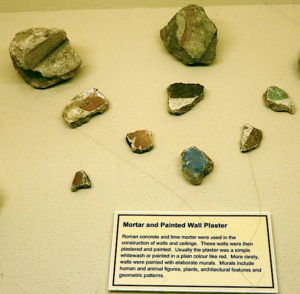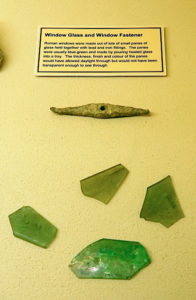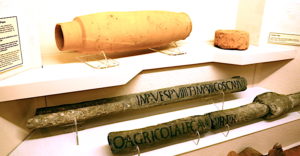The Grovenor Museum is probably best known for its remarkable collection of Roman artefacts. These are displayed in two galleries. The NEWSTEAD GALLERY covers life in Chester, and is split into two reviews. This covers buildings and building techniques. A second review covers everyday life.
The STORIES IN STONE GALLERY (separate review) has an impressive collection of Roman tombstones and altars.
I have been wanting to visit the museum for many years and it more than lived up to my expectations. Exhibits were well displayed with plenty of information. I learned a lot!
There is a model of Deva Roman Fort and also the amphitheatre, which really gives an impression of how large and important Deva was. The street plan in the centre of Chester still reflects that of the Roman city and Roman masonry can still be seen in the base of the north and eastern sections of the city walls.
The Romans were great builders and engineers from massive forts, to Roman villas and smaller domestic buildings. As well as using natural materials like wood and stone, they also used man made substances like mortar, plaster and cement as well as kiln fired products like clay tiles and glass. Lead was mined in North Wales and was also used for water pipes and weights.
A small ‘shelter’ has been built to demonstrate Roman building techniques. The roof is made from Roman tiles found in Chester. There were three different types of roof tile. The tegula was a large flat tile with raised edges that formed the base of the roof. These were laid side by side with slightly overlapping rows. The inbrices were tapering curved tiles that were placed over the edges of the tegulae and packed with cement to make the joints water tight. The top ridge was covered by rounded ridge tiles. The ends of the join between the tegulae and ibrex was covered by decorative antefixes .
Several different styles of floor covering were used depending on the status and purpose of the room. These varied from small tiles laid either flat or on end, fragments of broken tile embedded in cement tile or mosaics made from small coloured pieces of stone
The Romans understood the use of lime in making mortar, concrete and wall plaster. Walls were often painted and the remains of painted wall plaster are often found during excavations.
There are also fragments of window glass, which were usually blue green in colour. Glass was rare and windows were made of small panes of glass held together with lead or iron strips and fastenings.
Rooms were heated by hot air, either by underfloor hypocausts or through hollow box shaped tiles built in the walls.
The Romans brought piped water and underground sewage systems with them, using ceramic or lead water pipes
There are more photographs “here.”:https://www.sloweurope.com/community/threads/the-grosvenor-museum-and-roman-chester.6060/










